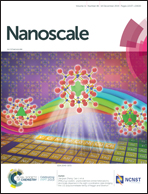The molecular mechanism of robust macrophage immune responses induced by PEGylated molybdenum disulfide†
Abstract
Molybdenum disulfide (MoS2), a representative hexagonal transition metal dichalcogenide (TMD), has been extensively exploited in biomedical applications due to its unique physicochemical properties and biocompatibility. However, the lack of adequate data regarding how MoS2 activates immunological responses of macrophages remains a key concern for its risk assessment. Here, we employ a combined theoretical and experimental approach to investigate the interactions of MoS2 and PEGylated MoS2 (MoS2-PEG) with macrophages. We first perform molecular dynamics simulations to examine the atomic-detailed interactions of MoS2 and MoS2-PEG nanoflakes with a realistic model of the macrophage membrane. We show that a small MoS2 nanoflake (edge length of 2.86 nm) is capable of penetrating the macrophage membrane independent of its concentration. We also demonstrate that when initiated with a corner point-on configuration, the surface-bound PEG chains of MoS2-PEG hinder its membrane insertion process, leading to a prolonged passage through the membrane. Moreover, when placed in a face-on arrangement initially, the MoS2-PEG exhibits a lower binding free energy than pristine MoS2 after its adsorption on the membrane surface. The PEG chains can even insert and get buried in the outer leaflet of the membrane, providing additional contact for membrane adsorption. Our flow cytometric experiments then show that the responses of macrophages to either MoS2-PEG or MoS2 are significantly higher than that of the control (no nanomaterial stimulus), with MoS2-PEG eliciting stronger cytokine secretion than the pristine MoS2. The characteristics of slower/prolonged membrane penetration and stronger membrane adsorption of MoS2-PEG compared to pristine MoS2 explain why it triggers more sustained stimulation and higher cytokine secretion in macrophages as observed in our experiments. Our findings reveal the underlying molecular mechanism of how MoS2-PEG influences the immune responses and suggest its potential applications in nanomedicine involving immune stimulation.

- This article is part of the themed collection: Theoretical Modelling at Nano-bio Interfaces


 Please wait while we load your content...
Please wait while we load your content...